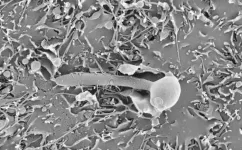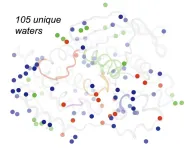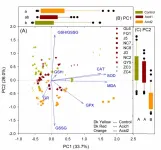(Press-News.org) (Boston)—Tuberculosis (TB) is the leading infectious killer worldwide, with 10.6 million cases and 1.6 million deaths in 2021 alone. One in five incident TB cases were attributable to malnutrition, more than double the number attributed to HIV/AIDS. Like HIV/AIDS, malnutrition is a cause of secondary immunodeficiency, known as nutritionally acquired immunodeficiency syndrome (N-AIDS). However, N-AIDS remains the neglected cousin of HIV/AIDS in global TB elimination efforts.
In a review paper led by Madolyn Dauphinais, MPH, researchers at Boston University Chobanian & Avedisian School of Medicine along with collaborators from Cornell University, University of Virginia, and the International Union Against Tuberculosis & Lung Disease, and Jawaharlal Institute of Postgraduate Medical Education and Research, reviewed decades of data and make the case that N-AIDS, just like HIV/AIDS, also deserves special consideration in the effort to eliminate TB.
“While there have been important technological advancements to detect and treat TB, our interpretation of the existing literature is that we won’t be able to make substantive changes in TB incidence and mortality rates without action on malnutrition,” explains corresponding author Pranay Sinha, MD, assistant professor of medicine at the school.
After reading more than 75 papers on nutrition and TB, the researchers briefly recount the impact that actions on HIV had on the global TB pandemic. They point out that malnutrition is the leading cause of immunodeficiency worldwide. “People with severe malnutrition, like people with HIV, are at increased risk of TB. We can leverage what we already know about malnutrition to aid us in detecting, treating and preventing TB,” says Sinha, who also is an infectious disease physician at Boston Medical Center.
While the researchers believe it is urgent to continue to develop newer tools, approaches should not be limited to the biomedical realm. For example, a study included in their review found that TB incidence among household contacts of persons with tuberculosis was reduced by 40% by providing them with an inexpensive food basket. “It is important for the lay audience to understand that TB is not simply a medical disease, it’s a social one and our elimination efforts must recognize that,” he adds.
According to the researchers, action on malnutrition will have several benefits beyond TB as well. Throughout their paper, they explore the idea of leveraging nutritional interventions to detect, prevent, and treat TB more effectively. They believe this paper will help advocates, clinicians, policymakers and voters think differently about the management of persons with TB as well as the needed global health investments to eradicate it.
This paper appears online in BMC Global & Public Health.
END
Nutritional acquired immunodeficiency (N-AIDS) is the leading driver of the TB pandemic
Acknowledging N-AIDS as a key determinant and comorbidity of TB can enhance the ability to detect, prevent and eliminate TB
2024-01-12
ELSE PRESS RELEASES FROM THIS DATE:
Obesity linked to detection of blood cancer precursor
2024-01-12
(WASHINGTON, January 12, 2024) – Individuals with obesity are more likely to have monoclonal gammopathy of undetermined significance (MGUS), a benign blood condition that often precedes multiple myeloma, according to new research published in Blood Advances.
Multiple myeloma is a blood cancer of the plasma cells, a type of white blood cells that produce antibodies to fight infection. MGUS, characterized by an abnormal protein produced by plasma cells, is a known precursor to multiple myeloma. Most people with MGUS exhibit no significant symptoms and are not immediately ill. Rather, the presence of MGUS serves as a warning to monitor for the potential ...
How gum disease aggravates chronic obstructive pulmonary disease
2024-01-12
Highlights:
Previous studies have connected severe gum disease to chronic obstructive pulmonary disease, or COPD.
Bacteria play a critical role, but the details remain unclear.
A new study shows how periodontitis, an oral disease, activates immune cells associated with aggravated progression of COPD.
The findings suggest that periodontitis and COPD together worsen COPD, and point to gum disease management as a potential treatment for COPD.
Washington, D.C.—Severe gum disease has been linked to the progression of chronic obstructive pulmonary disease, or COPD, but an understanding ...
ASM expands clinically relevant research with launch of ASM Case Reports
2024-01-12
Washington, D.C.—The American Society for Microbiology (ASM) announces the launch of its new fully open access journal, ASM Case Reports, which will begin publishing case reports in 2025 and accepting submissions starting mid-2024. ASM Case Reports will be a dedicated platform for the prompt publication of high-quality case reports in clinical microbiology and infectious diseases, an extensive and rapidly growing body of research.
ASM Case Reports will explore new diseases, elaborate disease progressions, the detailed actions and effects of pharmaceuticals, ...
Rice researchers revolutionizing 5G network testing
2024-01-12
With the potential to transform the future of global wireless networks, Rice University engineers are developing a cutting-edge testing framework to assess the stability, interoperability, energy efficiency and communication performance of software-based machine learning-enabled 5G radio access networks (RANs).
As 5G networks evolve toward more software-centric architectures, there is a critical need for advanced testing methods to ensure robust real-time performance. Funded by a $1.9 million grant from the U.S. Department of Commerce’s National Telecommunications and Information ...
Candida evolution disclosed: new insights into fungal infections
2024-01-12
Barcelona, 12 January 2024 – Global fungal infections, which affect one billion people and cause 1.5 million deaths each year, are on the rise due to the increasing number of medical treatments that heighten vulnerability. Patients undergoing chemotherapy or immunosuppressive treatments after organ transplant often present compromised immune systems. Given the emergence of resistant strains, the limited variety of current antifungal drugs as well as their cost and side effects, the treatment of these infections is challenging and brings about an urgent need for more effective treatments.
In this context, a team from the Institute for ...
Study reveals function of little-understood synapse in the brain
2024-01-12
New research from Oregon Health & Science University for the first time reveals the function of a little-understood junction between cells in the brain that could have important treatment implications for conditions ranging from multiple sclerosis to Alzheimer’s disease, to a type of brain cancer known as glioma.
The study published today in the journal Nature Neuroscience.
Neuroscientists focused on the junction, or synapse, connecting neurons to a non-neuronal cell, known as oligodendrocyte precursor cells, or OPCs. OPCs can differentiate into oligodendrocytes, which produce a sheath around nerves known as myelin. Myelin is ...
Spying on a shape-shifting protein
2024-01-12
NEW YORK, January 12, 2024 — Proteins do the heavy lifting of performing biochemical functions in our bodies by binding to metabolites or other proteins to complete tasks. To do this successfully, protein molecules often shape-shift to allow specific binding interactions that are needed to perform complex, precise chemical processes.
A better understanding of the shapes proteins take on would give researchers important insight into stopping or treating diseases, but current methods for revealing these dynamic, three-dimensional forms offer scientists limited information. To address this knowledge ...
Researchers sequence the first genome of myxini, the only vertebrate lineage that had no reference genome
2024-01-12
An international scientific team made up of more than 40 authors from seven different countries, led by the researcher at the University of Malaga Juan Pascual Anaya, has managed to sequence the first genome of the myxini –also known as ‘hagfish’–, the only large group of vertebrates for which there was no reference genome of any of its species yet.
This finding, published in the scientific journal ‘Nature Ecology & Evolution’, has allowed deciphering the evolutionary history of genome duplications –number of times a ...
Researchers uncover blood flow regulation of brain pericyte development
2024-01-12
In a study published online in Cell Reports, DU Jiulin’s group at the Institute of Neuroscience, Center for Excellence in Brain Science and Intelligence Technology of the Chinese Academy of Sciences, and the collaborators, created a zebrafish model for in vivo labeling of brain pericytes and systematically explored the developmental dynamics of brain pericytes during the early embryonic stage. The researchers revealed the promoting effect of blood flow on the proliferation of pericytes after ingress into the brain and showed that this process ...
Divergent responses of growth rate and antioxidative system of ten Bacillus strains to acid stresses
2024-01-12
Soil aciditification is widely occurring in diverse terrestrial ecosystems and soil microbial communities have been reported to be highly sensitive to changes in soil pH. Soil microbes could regulate their physiological conditions to make them survive under the aciditifying conditions. This study demonstrates that ten Bacillus strains are able to regulate the antioxidative system differently in response to the decreasing environmental pH condition, and therefore have different acid tolerance capacity. The researchers’ ...
LAST 30 PRESS RELEASES:
Study reveals that the body uses different sensors to detect cold in the skin and in internal organs
iPS cells from dish to freezer and back
Deep neural networks enable accurate pricing of American options under stochastic volatility
Collective risk resonance in Chinese stock sectors uncovered through higher-order network analysis
Does CPU impact systemic risk contributions of Chinese sectors? Evidence from mixed frequency methods with asymmetric tail long memory
General intelligence framework to predict virus adaptation based on a genome language model
Antibiotic resistance is ancient, ecological, and deeply connected to human activity, new review shows
Vapes, pouches, heated tobacco, shisha, cigarettes: nicotine in all forms is toxic to the heart and blood vessels
From powder to planet: University of Modena engineers forge a low-carbon future for advanced metal manufacturing
Super strain-resistant superconductors
Pre-school health programme does not improve children’s diet or physical activity, prompting call for policy changes, study finds
Autumn clock change linked to reduction in certain health conditions
AI images of doctors can exaggerate and reinforce existing stereotypes
Where medicine meets melody – how lullabies help babies and parents in intensive care
We may never be able to tell if AI becomes conscious, argues philosopher
AI video translation shows promise but humans still hold the edge
Deep ocean earthquakes drive Southern Ocean’s massive phytoplankton blooms, study finds
Without campus leftovers to pick through, the beaks of this bird changed shape during the pandemic
High-dose antibiotic does not reduce mortality in tuberculous meningitis
How many insects fly in the sky above the USA?
Could cheese protect your brain health?
Who faces more difficulty recovering from stroke?
Colliding galaxies create the brightest, fastest growing black holes at their center
New BrainHealth research reveals tradeoffs on sleep with cannabis use for chronic pain
Aging-US now on ResearchGate, enhancing visibility for authors and readers
'Molecular glue' stabilizes protein that inhibits development of non-small cell lung cancer
Mount Sinai Health System is recognized in 2025 Chime Digital Health Most Wired survey
From prey to predator: How carnivores spread beneficial fungi
Menopause symptoms may be frequent and have negative effects, according to female endurance athletes
US Congressmembers’ responses on X to mass shooting events differ along party lines
[Press-News.org] Nutritional acquired immunodeficiency (N-AIDS) is the leading driver of the TB pandemicAcknowledging N-AIDS as a key determinant and comorbidity of TB can enhance the ability to detect, prevent and eliminate TB



